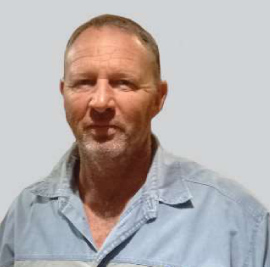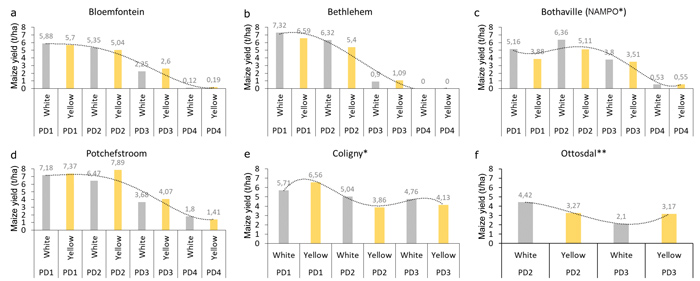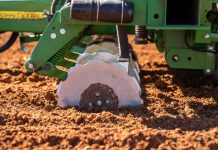
Dr Nicky Creux, FABI, University of Pretoria

Deon du Toit,
ARC-Grain Crops

Theodora Mathobisa, ARC-Grain Crops

Dr Gert Ceronio, University of the
Free State
In major maize production regions of South Africa, the optimal planting date for maize is considered to be around late October to mid-December for Mpumalanga (22%), the Free State (43%) and North West (17%), respectively. In these regions maize production is predominantly dry-land, which makes planting date highly dependent on the onset of the rainy season.
During wet climatic cycles driven by La Niña, this is less of an issue as the rains tend to be early or on time. However, in dry cycles driven by El Niño, droughts and late rains become a common feature limiting planting date options (Abdi et al., 2016). As climate change progresses, it is projected that the extreme weather events that accompany these cycles, including droughts, floods and heat waves, are expected to get more severe, more frequent and have prolonged durations. In the previous dry cycle, from 2015 to 2019, there were many reports of late plantings and poor yields, because these circumstances do not provide producers with much flexibility to select and plant at the optimal planting date. Understanding what can be expected from a specific planting date can become critical in managing yield and production under these different and variable climatic conditions.
There are several risk factors associated with specific planting dates that are easy to identify, particularly at the very early or very late planting dates. At very early planting dates (October) a major risk is low moisture, low soil temperature and limited rains or mid-summer drought, which will disrupt field preparation, planting, germination and flowering. On the other hand, very late planting dates (late January) are limited by the onset of frost and low heat unit accumulation, limiting plant growth and yield (Moeletsi, 2017).
When looking at the moderately early (November) or moderately late (early January) planting dates, the factors that might influence crop development and yield are not as obvious. The question then: What are the risk factors associated with the moderately early or moderately late planting dates? Multiple year planting date trials are an important tool to assess how planting date might impact maize yield as the seasons cycle through wet and dry periods under changing climates. In a collaborative project between the ARC-Grain Crops, the University of the Free State and the Forestry and Agricultural Biotechnology Institute (FABI) at the University of Pretoria under the Grain SA Climate Resilience Consortium, the aim was to assess these planting dates across several locations in North West and the Free State for six maize cultivars.

Trial information
This study was conducted over three seasons from 2019/2020 to 2021/2022. Sites included three experimental farms (Bethlehem, Bloemfontein and Potchefstroom) as well as Bothaville (NAMPO, added in 2020/2021) and Ottosdal/Coligny. Ottosdal and Coligny are working farms that required alignment to producers’ practices, leading to planting being done at only two or three dates. Only one season was completed in Coligny, whereafter the site was moved to Ottosdal, where two seasons were completed. Three white maize cultivars (DKC 75-65BR, DKC 77-77BR and DKC 78-45BR-GEN) and three yellow maize cultivars (DKC 71-44B, DKC 72-76BR and DKC 74-26R) were planted in three replicated randomised plot designs.
Four planting dates were planned and executed as weather conditions allowed, predominantly within the weeks of 15 to 20 November (PD1), 15 to 20 December (PD2), 13 to 18 January (PD3) and 1 to 5 February (PD4) of each season. February is a very late planting date and acted as a negative control to compare the other planting dates to as poor performance and limited yields were anticipated for this planting date. Yield traits were measured for each planting throughout each season.
Trial outcome
In general, this trial showed that December 15 (PD2) is the optimal planting date in most locations studied (Figure 1). In Bloemfontein, Bethlehem and Potchefstroom the earlier November planting date (PD1) performed similarly to PD2. In all cases except Coligny a large drop in yield was observed in the January planting date (PD3). In Bloemfontein, Bethlehem and Potchefstroom PD3 lost approximately 50% or more in yield when compared to PD2 (December). Bothaville and Ottosdal still showed a decrease in yield at PD3, but the losses were less severe. These results were mostly consistent across both yellow and white cultivars. Coligny and Ottosdal showed less consistent results due to trial conditions, predation and limited options for trial management, which resulted in not all planting dates or seasons being completed as planned.
Concluding remarks
The planting date trials running from 2019/2020 to 2021/2022 have revealed that, regardless of location, season or cultivar, planting on 15 January or later resulted in large decreases in yield of up to 50%. These trials have mostly spanned the current wet cycle and it will be interesting to maintain these trials through the next dry cycle to asses if or how the planting dates might be affected in the next cycle. The sharp drop from 15 December to 15 January is surprising and raises questions about where in these four weeks the drop-off specifically occurs and what factors might be underlying this significant drop in yield. The next phase of the project will begin to address these questions in the coming season.
This research project was made possible through funding from the Department of Science and Innovation, the Technology Innovation Agency and the Maize Trust.
References
- Abdi, AM, Vrieling, A, Yengoh, GT et al. 2016. The El Niño – La Niña cycle and recent trends in supply and demand of net primary productivity in African drylands. Climatic Change, 138, 111 – 125.
- Moeletsi, ME. 2017. Mapping of Maize Growing Period over the Free State Province of South Africa: Heat Units Approach. Advances in Meteorology, 2017, 1 – 11.




























